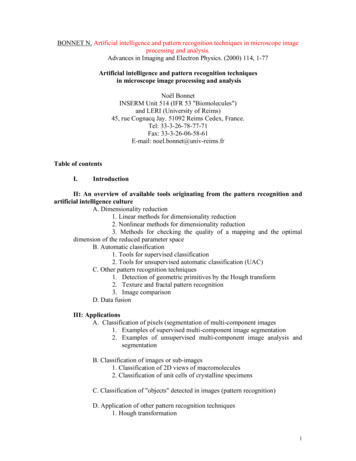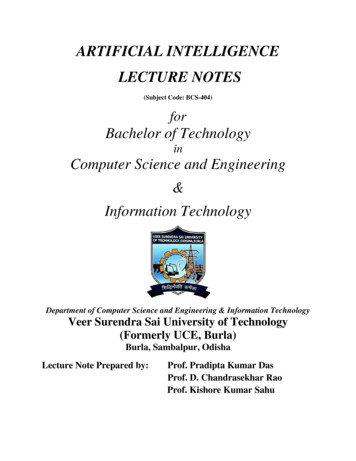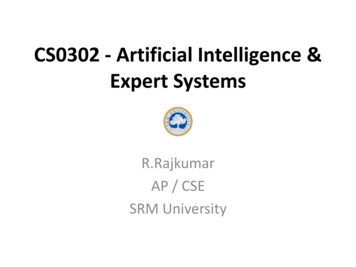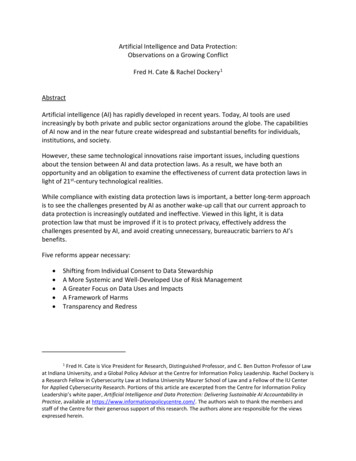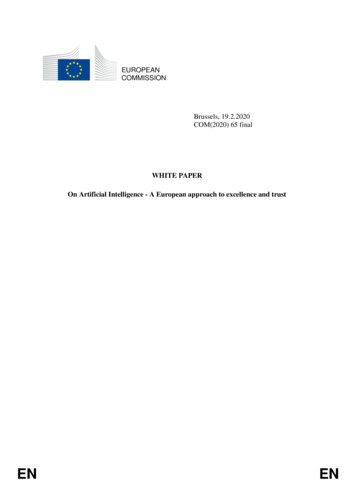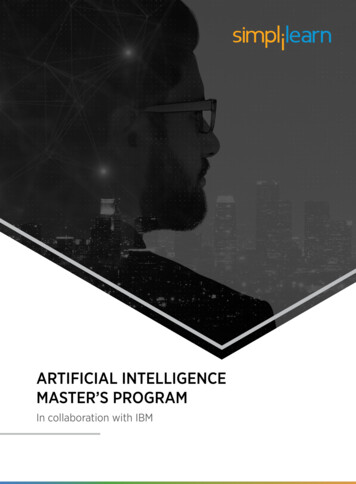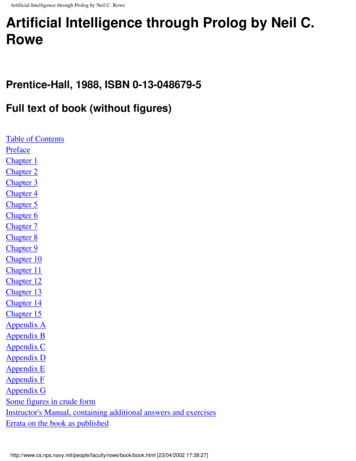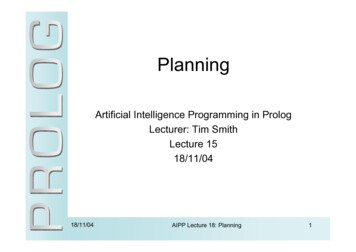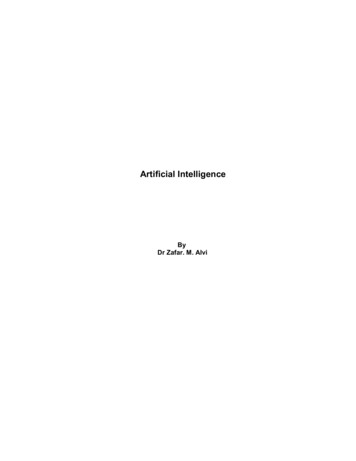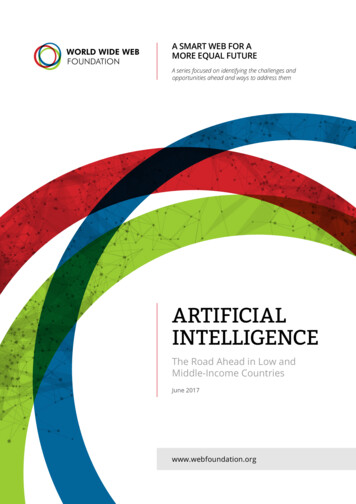
Transcription
A SMART WEB FOR AMORE EQUAL FUTUREA series focused on identifying the challenges andopportunities ahead and ways to address themARTIFICIALINTELLIGENCEThe Road Ahead in Low andMiddle-Income CountriesJune 2017www.webfoundation.org
CONTENTSForeword3Introduction401 The Opportunities602 The Risks8The Context1204 A Way Forward16051803References and AppendicesThe Web Foundation was established in 2009 by Sir Tim Berners-Lee,inventor of the World Wide Web. Our mission is to establish the openweb as a public good and a basic right.This paper has been adapted by the Web Foundation from a draftreport commissioned to Cath Elliston, Matt Fenech, and Olly Buston ofFuture Advocacy.This research was funded by a grant from the Ford Foundation.Copyright, World Wide Web Foundation, CC BY 4.0
FOREWORDWelcome to this new series of policy white papers, producedby the World Wide Web Foundation.The Web Foundation was established in 2009 by Sir Tim BernersLee, inventor of the World Wide Web. Our mission is to establish theopen web as a public good and a basic right. Our five-year strategy– developed in 2016 – is to deliver digital equality – a world whereeveryone has the same rights and opportunities online. To achievethis vision, we must keep an eye on the trends, technologies andforces shaping the web of tomorrow, and the policy interventionsthat will be required to ensure digital equality becomes a reality.“To achieve this vision, wemust keep an eye on thetrends, technologies andforces shaping the web oftomorrow, and the policyinterventions that will berequired to ensure digitalequality becomes a reality.”On the web’s 28th birthday in March 2017, Sir Tim Berners-Leepenned a letter on what he believed to be the biggest challengesfacing the web today. The challenges he outlined are threefold:we've lost control over our personal data; misinformationspreads too easily online; and we need more transparency andunderstanding of digital political advertising.Since then we have been discussing ways in which we could andshould tackle these issues. We understood that these could beearly warning signals of deeper problems, and set out to distilthese in search of their most basic components. We landed upondata, algorithms and artificial intelligence, and the way theseinteract with existing socio-legal frameworks. These three issuesare interdependent – data feed algorithms that are increasinglybeing used to make critical decisions, algorithms are the bedrockof artificial intelligence, and data gathered by AI and algorithmsfeed back into the system.This is one of the three white papers we commissioned to beginto understand more about these issues. All too often, research,debate and discussion on these areas is focused on the US, UKand Europe, while actors from outside these countries are seldombeing included as critical actors in thinking through policies at theglobal level. Our objective was to gain initial insights into how eachcomponent is currently playing out in low and lower-middle incomecountries, and what some of the future risks and opportunities are.An important step towards enabling collaboration and solving thechallenges the web faces is increasing public and key stakeholderunderstanding of how the individual components of the systemwork. We hope that these papers make a small contribution towardsthis goal, including in countries too often ignored in these debates.We will now be using these papers to refine our thinking and setour work agenda in the years ahead. We are sharing them openlyin the hope that they benefit others working towards our goals.We hope you enjoy the read, and we welcome your feedback. Let’swork together to build a more open web for a more equal world.Craig FaganDirector of Policy, Web FoundationJune 2017www.webfoundation.org3
Artificial Intelligence: The Road Ahead in Low and Middle-Income CountriesINTRODUCTIONWe are in the early stages of a global intelligence revolution.Artificial Intelligence (AI) already permeates many aspectsof our lives. All over the world, AI systems filter email spam,recommend things for people to buy, provide legal advice oneverything from parking tickets to asylum applications, and in someplaces can determine whether you are paid a visit by the police.1,2Research by McKinsey has gone as far as describing AI ascontributing to a transformation of society “happening ten timesfaster and at 300 times the scale” of the Industrial Revolution.3Defining AI is difficult, not least because ‘intelligence’ itself isdifficult to define. In this paper we will use an inclusive definition ofintelligence as ‘problem-solving’ and consider ‘an intelligent system’to be one which takes the best possible action in a given situation.4Although AI is not new, there has been a recent explosion ofactivity and interest in the field, which has largely been drivenby advances in ‘machine learning’, and the related field of ‘deeplearning’. These are computer programs that learn and improvewith experience.5 Progress in machine learning has allowed moreversatile AI systems to be developed that can perform well at arange of tasks, particularly those that involve sorting data, findingpatterns, and making predictions (see Figure 1). The trainingprocess can involve in practice adjusting for millions of parametersrelative to computational efforts of the machine being used with“astronomically more possible outcomes than any algorithm couldever hope to try.”61‘ Chatbot that overturned 160,000 parking fines now helping refugees claimasylum’, retrieved from /chatbot-donotpay-refugees-claim-asylum-legal-aid, accessed on 10 March, 2017 2 The Chicago police department have used predictive policing to visit those ata high risk of committing an offence to offer them opportunities to reducethis risk, such as drug and alcohol rehabilitation or counseling. See Saunders,J., Hunt, P., & Hollywood, J. S. (2016). Predictions put into practice: a quasiexperimental evaluation of Chicago’s predictive policing pilot. Journal ofExperimental Criminology, 12(3), 347-371 and Stroud, M. (2016, 19 August)Chicago’s predictive policing tool just failed a major test. The Verge (retrievedfrom http://theverge.com, accessed on 11 October, 2016). Areas of the UK,such as Kent, are beginning to use predictive policing. E.g. see O’Donoghue,R. (2016, 5 April) Is Kent’s Predictive Policing project the future of crimeprevention? KentOnline (retrieved from http://kentonline.co.uk, accessed on 10March, 2017). 3 Dobbs, Richard, James Manyika, Jonathan Woetzel, (2015) ‘The four globalforces breaking all the trends’, McKinsey Global Institute4 Russell, S. J., and Norvig, P., (1995) Artificial Intelligence: A Modern Approach,Englewood Cliffs, NJ: Prentice Hall. 5 Mitchell, T. (1997) Machine Learning. London, UK: McGraw-Hill Education.6 Preparing for the Future of artificial intelligence, (Oct 2016), Executive Officeof the President National Science and Technology Council Committee onTechnology ing for the future of ai.pdf4www.webfoundation.org
IntroductionFigure 1 — Artificial intelligence (AI), machine learning and deep learning7ARTIFICIAL INTELLIGENCE is the study of devices that perceivetheir environment and define a course of action that will maximizeits chance of achieving a given goal.8ARTIFICIALINTELLIGENCEMACHINE LEARNING is a subset of artificial intelligence, in whichmachines learn how to to complete a certain task without beingexplicitly programmed to do so.MACHINELEARNINGDEEP LEARNING is a subset of machine learning in which the tasksare broken down and distributed onto machine learning algorithmsthat are organised in consecutive layers. Each layer builds up onthe output from the previous layer. Together the layers constitutean artificial neural network that mimics the distributed approachto problem-solving carried out by neurons in a human brain.DEEPLEARNINGA considerable body of literature exists on the social and economicimpact of AI.9 To date almost all of this work has been focused onthe implications of AI for people living in higher income countriessuch as the EU, UK and US. The focus of this paper is on theimpact of AI on people living in low and middle-income countriesfor whom many of the same opportunities and risks apply (oftento a greater extent), along with additional opportunities and risksunique to these countries. As one of our interviewees noted, thediscourse around technology is universalising, but social andeconomic contexts are crucial.The report provides a detailed outlook of the risks and opportunitiesartificial intelligence (AI) poses for low and middle income countries,as well as the key elements that can be leveraged upon to maximisethe benefits and minimize the risks generated by AI. The insightsprovided throughout the paper are the result of over two dozenin-depth interviews with key experts and practitioners based inthese countries and an extensive literature review.7 Loosely based on an infographic developed by David Sangokoya, DataPop Alliance8 Poole, David; Mackworth, Alan; Goebel, Randy (1998). Computational Intelligence: A Logical Approach. New York: Oxford University Press.9 ‘An intelligent future? Maximising the opportunities and minimising the risks of artificial intelligence in the UK’, 25 October, 2016. Available at ture-3.pdfwww.webfoundation.org5
Artificial Intelligence: The Road Ahead in Low and Middle-Income Countries01THEOPPORTUNITIES1.1 mployment, Economic GrowthEand Redistribution of WealthAI is already enabling a wave of innovation across many sectorsof the global economy. It helps businesses use resources moreefficiently (e.g. through automated planning, scheduling, optimisedworkflows, optimised supply chains, optimised logistical pathways)and enables entirely new business models to be developed, oftenbuilt around AI’s powerful ability to interrogate large data sets. Manybusinesses in low and middle income countries will benefit fromthese AI capabilities, translating into greater opportunities for smallentrepreneurs to develop new businesses. The São Paulo-basedstart-up QuintoAndar, for example, has changed the property rentalmarket by using machine learning to optimise pricing, leading tobenefits for both the homeowners (whose properties spend lesstime on the market) and for tenants (who have access to betterprices).10 In Nigeria, Kudi.ai uses natural language processingand other AI-based technology to provide mobile banking andconversational payment services to users who are unfamiliar orunable to interact with traditional browser-based online bankingsystems, but can interact with a familiar text-based messagingsystem.11 Across Africa, micro-credit platforms, while sometimescontroversial, are leveraging AI to define how to measure risk whenpotential clients do not have a traditional credit ’footprint’.12 AI isalso used for fraud detection and operational optimisations aspart of these platforms.13These advancements promise to provide further dynamism to localeconomies by reducing transaction costs associated with lack ofinformation. This applies to the issue of basic government data.There are expectations that AI may help to cost-effectively improvethe quality of national statistics (for example on employmentand wealth) that are needed for good economic planning andpolicy-making.1.2 elivery of Public ServicesDand Public GoodsThere are plenty of instances where AI is being used to improvedelivery of public services and public goods in low and middleincome countries, ranging from pilot projects to larger scale roll out.AI seems particularly fit for simplifying transactions on governmentwebsites.AI has also been deployed as a response to public health concerns,such as to anticipate outbreaks of diseases such as Zika and denguefever. For example, the Brazilian NGO Viva Rio partnered withstart-up AIME (Artificial Intelligence in Medical Epidemiology) whichanalyses existing local government datasets in combination withsatellite image recognition systems to deploy low cost predictionsof where we should expect greater incidence of disease in anupcoming three month period. Notably, the technology wasdesigned to work in Malaysia, but it had success rates of 84%diagnosis in Brazilian trials14. Following its low cost success in Brazil,AIME has been deployed in Dominican Republic.10 Interview with Helio Perroni Filho, 30 March, 201711 Interview with Pelumi Aboluwarin, 1 March, 201712 Interview with Yasaman Hadjibashi/Rani Shah, 21st March 201713 Wright, B. “Can AI bring fintech to Africa and help bank the ‘unbanked’?” IDGConnect, available at ingfintech-africa-help-bank-unbanked (accessed on 29 March, 2017)14 2015, AIME Pilot To Work in Sao Paulo (Brazil) Starting Next January 2016,viewed 8th June 2017, http://aime.life/Post/get/886
Section One: The OpportunitiesIn other cases, AI has been used to improve police coverage,such as in dealing with transit issues. In Uganda15 AI is usedto advise individuals or emergency vehicles on optimal routes,dynamically redeploying a limited number of traffic police officials,and analysing possible reconfigurations of the road network toremove bottlenecks.In other cases it has been used for environmental ends. In Kenya,for example, the World Wildlife Fund (WWF) supports the use ofan AI device with drones. After nine months, over a dozen huntershad been apprehended in the Maasai Mara. WWF has received a 5 million grant from Google.org to employ this AI-powered deviceto protect wildlife.16AI has also been used for agricultural matters, including identifyingcrop disease with a smartphone.17 Mcrops, developed in Uganda,is a diagnostic tool for diagnosing viral crop diseases in cassavaplants.18 Sick plants are flagged in real time, which allows farmersto take action and stop the spread of the disease.19 In Nigeria,AI is being employed to help farmers sell their produce and buyservices via a bot platform that relies on SMS and other channelssuch as USSD, Slack, etc. 20Finally, AI has been used to prevent and predict natural disasters.The Red Cross/Red Crescent Climate Centre has an on-going projectwith Togo’s Nangbéto Dam, which frequently overspills, causinggreat disruption to the livelihoods of people living downstream. Inthe past models were poor at predicting the likelihood of overspill,but using a combination of crowdsourced information (including bymobile phone) and AI techniques, an improved model of overspillprediction was developed.21 Also, the Netherlands Red Cross’ 510data initiative has developed models using data from previousnatural catastrophes to allow better resource management andprioritization of aid.22 It was employed after Typhoon Haima in thePhilippines in 2016, and proven to be accurate after a comparisonwith data on damaged property.231.3 Strengthening DemocracyIn many countries, in order to fully participate politically andeconomically, citizens still generally need to read/speak English,French, Portuguese or another colonial language, which is oftenthe main language of government. This is a major barrier forparticipation in civic life for those who speak an indigenous languageor who are illiterate.AI-based automated translation and voice recognition systemscould have significant impact in countries with multiple languages.This is the case for numerous low and middle income countries,including India, Indonesia and Nigeria. These systems could alsohave an impact in places with high levels of illiteracy, allowing peopleto engage with the government or public service provision interfacesby spoken rather than by written means. This would particularlybenefit marginalised groups who experience disproportionate ratesof illiteracy. Globally, 87% of men can read and write, comparedto only 77% of women who can do so. This contrast is especiallypronounced in Afghanistan and Niger, in which around three timesmore women than men are illiterate.24Shashi Shekhar Vempati, an Indian digital policy expert,25 gave astriking example of this. He explained the process by which topicsfor discussion during Indian Prime Minister Modi’s monthly radioaddress are chosen. A call for contributions is placed in advanceof addresses, and suggestions of issues to discuss flood in fromall over the country in over 27 different languages and dialects viaa mobile app, an online government portal, and even postcards.The sheer volume of these contributions makes it exceedinglydifficult to take them all into account. But technology that organises,translates and even analyses them to extract common themeswould ensure that the views of hitherto excluded groups arerepresented.26 Similarly, Professor Tommie Meyer, of the Centrefor Artificial Intelligence Research (CAIR) in South Africa, indicatedthat this is an area CAIR is working on. By enabling greater access ofminority language speakers (South Africa has 11 official languagesand many local dialects) to public services and publicly availableinformation, the team at CAIR hopes to better engage thesedemocratically marginalised people with the democratic process.27One challenge to these approaches is that machine translationmodels tend to be refined with scale of usage, and currently mainlyrely on written language to train the models. This may not be viablefor some less widely used languages yet, but machine translationmodels already exist for some of the more widely spoken languagesin low and middle income countries.2815 Q uinn, J., Frias-Martinez, V. and Subramanian, L. (2014) ‘Computational sustainability and artificial intelligence in the developing world’, AI Magazine, 35(3), pp. 36–47.16 Lorica, D. (2016) ‘Artificial Intelligence Used To Catch Poachers In Kenya’ available at 4bsTbOl8A17 Gill, C. (2016) ‘Artificial intelligence could help farmers diagnose crop diseases’, available at ose-crop-diseases, accessed 13th March 201718 Gill, C. (2016) ‘Artificial intelligence could help farmers diagnose crop diseases’, available at ose-crop-diseases, accessed 13th March 201719 Mcrops website accessed 22/3/17 at http://air.ug/mcrops20 Email communication from Sanusi Ismaila, 2 February 201721 Interview with Michael Veale, 24 February, 2017.22 Interview with Maarten van der Veen, 9th March 201723 For more information see https://510.global/tag/disasters/27/3/17, accessed 13th March 201724 Graham, M., Hale, S. A. and Stephens, M. (2011) Geographies of the World’s Knowledge http://www.oii.ox.ac.uk/publications/convoco geographies en.pdf,accessed 14th March 201725 Since our interview with Shashi Shekhar Vempati, he has been appointed CEO of Prasar Bharati, India’s Public Broadcaster.26 Interview with Shashi Shekhar Vempati, 28th February 201727 Interview with Tommie Meyer, 24 February 201728 Khemani, D. (2012) ‘A Perspective on AI Research in India’ AI Magazine 33(1);96-8www.webfoundation.org7
Artificial Intelligence: The Road Ahead in Low and Middle-Income Countries02THE RISKS2.1 mployment, Economic GrowthEand Redistribution of WealthA lot of attention has been given to the upheaval of employmentmarkets that AI will cause in high-income countries. However, theWorld Bank Development Report (2016) estimates that the ‘share ofoccupations that could experience significant automation is actuallyhigher in lower income countries than in higher ones, where manyof the jobs susceptible to automation have already disappeared,and this concerns about two thirds of all jobs’.29 The impact onlow and middle income countries could indeed be profound butis likely to vary significantly in different countries depending ontheir demographics and the makeup of their economies. Table 1shows the World Bank’s predictions for the automatable shareof employment in some countries of particular interest for theWeb Foundation.Although the World Bank has adjusted these figures based on an‘adoption time lag’, it does feel that these predictions should betaken with further caution. It was pointed out in our interviews thatmany low and middle income countries lack the communication,energy and other infrastructures that are required to support highlyautomated industries30. Also, regulation (local and/or global) woulddirectly impact the evolution and adoption of these technologiesin ways that are difficult to foresee.However, it is reasonable to assume that a significant level ofautomation will take place in low and lower middle income countries.Improvements to microprocessors means that as workers shiftfrom executing the tasks directly to operating or supervisingmachines, companies could soon rely on groups of workers that aresmaller in number but more technically skilled.31 The 2016 WorldBank Development Report finds that the distributional impactsof robots on employment and income in low and middle incomecountries will ‘at least initially, tend to move against inclusiveness,as in high income countries countries’. Job creation will likely beconcentrated in high-skilled activities with comparatively fewerbenefits for low-skilled and medium-skilled workers32.Automation in high income countries could erode the labourcost advantage of low and middle income countries, taking awaya traditional route to development. The path pursued by theEast Asian Tigers, and later by China and India, simply may notbe available in the future. Ian Goldin, founding Director of theOxford Martin School and currently Professor of Globalisation andDevelopment at Oxford University, noted that the price of capital,not the price of labour, will determine the location of productionas technology gets better. Places where capital markets are moredeveloped thus have a great advantage over places where capitalmarkets are thin.33The impact of automation will not just be felt in manufacturing.Jobs in lower-skilled service sectors like call centre work are alsoripe for automation, as well as some of the tasks involved inhigher-skilled professions. Indeed the very things that made certainjobs easy to outsource may make them easy to automate. Theconsequences of this could be stark. India’s IT boom was basedon Indian IT professionals providing services to customers in high29 World Bank (2016), World Development Report 2016: Digital Dividends.Washington, DC: World Bank. doi:10.1596/978-1-4648-0671-1. License:Creative Commons Attribution CC BY 3.0 IGO30 Interview with Michael Veale, 24 February, 201731 United Nations Conference on Trade and Development (UNCTAD) (2016),‘Robots and Industrialisation in Developing Countries’, UNCTAD, sspb2016d6 en.pdf32 Ibid33 Interview with Ian Goldin, 15 March 20178
Section Two: The RisksTable 1 — Estimated share of employment that is susceptibleto automation in key countries of interest.COUNTRYAUTOMATABLE SHARE OF EMPLOYMENTUNADJUSTED FOR ADOPTION TIME LAG (%)AUTOMATABLE SHARE OF EMPLOYMENTADJUSTED FOR ADOPTION TIME LAG (%)ETHIOPIA84.943.9INDIA68.942.6SOUTH AFRICA66.547.9NIGERIA65.040.2DOMINICAN REPUBLIC62.244.7OECD AVERAGE57.057.0Source: World Bank. 2016. World Development Report 2016: Digital Dividends. Washington, DC: World Bank. doi:10.1596/978-1-4648-0671-1.License: Creative Commons Attribution CC BY 3.0 IGOincome countries. Shashi Shekhar Vempati claimed, however, that“algorithmic tools have replaced a lot of these professionals in thelast 12 to 18 months”.34 We have been unable to independentlyverify this claim, but it is certainly clear that many Indian andmultinational companies are actively developing chatbots to handleinteractions with customers.35, 36, 37 This point is echoed by UrvashiAneja, Founding Director of Tandem Research in India.38 Sheindicated that the “employment crisis” in India is well recognised,describing a “youth bulge” of young men aged 17-25 who arelikely to constitute the majority of the people looking for the 250million jobs that need to be created by 2030. “The problems aresevere enough even without thinking about AI; add in AI and theproblems become more urgent.”39While the impact on the employment market for many Indian mencould be significant, the picture for women across the world couldbe even more devastating. Just 14% of women were in full-timeformal employment – an indicator of a ‘good’ job – compared with33% of men across 17 countries in the Middle East, NorthernAfrica, and Sub-Saharan Africa regions of the world (consideredto be regions with the highest gender inequality).40,41 This meansthat while automation could affect more men than women, thereduction in job opportunities could exacerbate inequalities asmore men compete with women for fewer jobs.This could be compounded by sector growth and decline. TheWorld Economic Forum (WEF) Future of Jobs Report found thatlabour market disruptions are likely to be concentrated in some ofthe job families with the largest share of female employees, suchas office and administrative functions.42 Jenny McAllister, LabourSenator for New South Wales (Australia), also argues that sectorgrowth could exacerbate wage inequality. While there might bemore demand for care sector roles, dominated by women, theseroles are likely to be low paid. On the other hand, there is likely tobe a growth in demand for high wage STEM (Science, Technology,Engineering, and Math)-related jobs, where women are strikinglyunderrepresented.43 Sector growth could thus entrench the ‘genderpay gap’. The 2016 WEF Report on gender disparities in industryfound that if current ratios persist over the 2015–2020 periodthere will be nearly one new STEM job created for every four jobslost for men, but only one new STEM job created for every 20 jobslost for women.44Of course, women are not a homogenous group, and these impactswill vary greatly among women of different ages and ethnicities indifferent countries. Female labour force participation varies acrossdifferent regions, from 26% in the Middle East and North Africa, to35% in South Asia, to 61% in Sub-Saharan Africa45. At a country level,these numbers range from just 27% in India and 44.5% in SouthAfrica; to 48.2% in Nigeria, 51.3% in Dominican Republic, 51.4%in Indonesia, and 59.4% in Brazil. Furthermore, a 2013 study ofglobal employment trends found that 49.1% of the world’s workingwomen were in vulnerable employment, often unprotected bylabour legislation, compared to 46.9% of men. Women were morelikely than men to be in vulnerable employment in East Asia (50.3%versus 42.3%), South-East Asia and the Pacific (63.1% versus 56%),34 Interview with Shashi Shekhar Vempati, 28 February 201735 Deoras, S. (2016) “10 Chatbots from India making it big!”, Analytics India Magazine, available from ing-big/ (accessed on 29March, 2017)36 Interview with Amber Sinha and Sumandro Chattapadhyay, 29 March, 201737 Chathurvedula, S. (2016) “Five Indian start-ups using bots in different ways”, available from -ways.html (accessed on 29 March, 2017)38 Tandem Research is a think tank focusing on policy for issues of technology, sustainability and governance.39 Interview with Urvashi Aneja, 27 February 201740 Stotsky, J.G., Shibuya, S., Kolovich, L. and Kebhaj, S. (2016) ‘Trends in gender equality and women’s advancement.’ Washington, DC: IMF41 Hunt, A. and Samman, E. (2016), ‘Women’s economic empowerment: Navigating enablers and constraints’, Overseas Development Institute Research Report, ODI, London42 World Economic Forum (2016), ‘The Future of Jobs: Employment, Skills and Workforce Strategy for the Fourth Industrial Revolution’, available at http://www3.weforum.org/docs/WEF FOJ Executive Summary Jobs.pdf (accessed 4 March 2017)43 McAllister, J. ‘Automation will embed gender inequality at work – unless we fix it now’, The Guardian, 8 November, 2016, available from -at-work-unless-we-fix-it-now (accessed 5 March 2017)44 The Industry Gender Gap Women and Work in the Fourth Industrial Revolution (2016) World Economic Forum (http://www3.weforum.org/docs/WEF FOJ Executive SummaryGenderGap.pdf accessed 9 March 2017).45 World Bank (2012), World Development Report 2012: Gender Equality and Development. Washington, DC: World Bank (pg 10) /Complete-Report.pdfwww.webfoundation.org9
Section Two: The RisksSouth Asia (80.9% versus 74.4%), North Africa (54.7% versus 30.2%),the Middle East (33.2% versus 23.7%) and Sub-Saharan Africa(nearly 85.5% versus 70.5%).46 More targeted interventions aimedat disadvantaged groups, like STEM skill programs for women, andgovernment investment in digital literacy, could help ensure thatthese groups do not get left further behind.There is also the risk of ‘brain drain’ in the AI space.47 Sharma Punitdescribes the case of 25-year-old Tushar Chhabra, co-founder ofCron Systems, which builds internet of things-related solutionsfor the defence sector.48 He is quoted as saying that an IndianInstitute of Technology (IIT)-educated engineer based in the US andworking on AI for seven years “asked for Rs2.5 crore [ 375,000]per annum as salary. As a start-up you cannot afford that price.”Thus, the higher pay and increased opportunities in high-incomecountries act as a significant pull factor, leading to a dearth oftrained, exp
com/s/An-intelligent-future-3.pdf ARTIFICIAL INTELLIGENCE is the study of devices that perceive their environment and define a course of action that will maximize its chance of achieving a given goal.8 MACHINE LEARNING is a subset of artificial intelligence, in which machi
